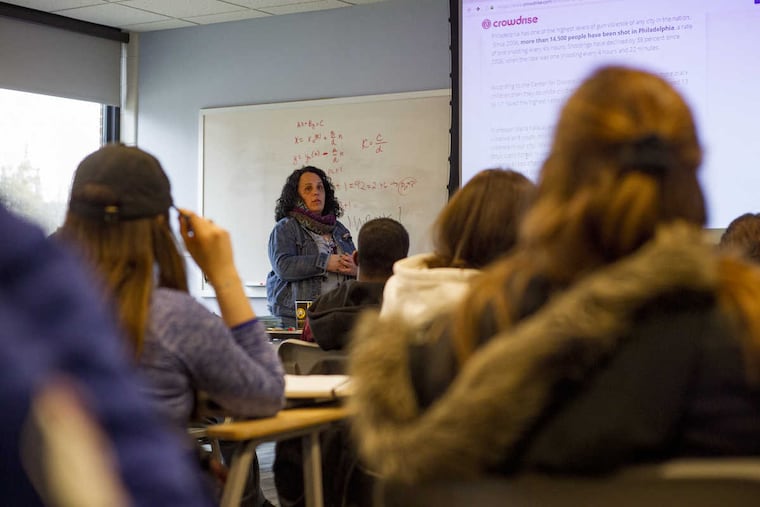Right now we're dealing with the rarest form of the gun-violence disease | Helen Ubiñas
"You could take the number of people killed in every mass school shooting since Columbine - then double it - and it still wouldn't equal the number of people killed by guns in Philly last year alone."

Around the time that funding was drying up for her antiviolence center, Maria Kefalas began raising money to support research for the rare and incurable disease afflicting her youngest daughter.
Her 8-year-old, Calliope Joy Carr, was diagnosed in 2012 with metachromatic leukodystrophy, a form of a degenerative neurological disease so uncommon that by one estimate it strikes one in 40,000 to 160,000 children.
Kefalas was struck by people's generosity. But as a longtime antiviolence advocate, she also couldn't help but recall all the hours spent trying to get people to care about the gun violence affecting thousands of children in Philadelphia, all but begging them to put their efforts and money where their flashes of empathy were.
Last year, more than two dozen of Philadelphia's 77,000 young men between the ages of 13 and 19 were murdered. That's about 30 times the mortality rate of the leukodystrophy that Kefalas' daughter is battling.
But people didn't open their wallets to wage war on violence.
The St. Joseph's University professor of sociology and criminal justice and director of the now-defunct antiviolence Richard Johnson Center was characteristically blunt:
Her fund-raising techniques hadn't changed — she was using the same lessons learned raising money for antiviolence efforts as she was on her cupcake fund-raisers for her daughter's disease.
"It was the issue," she concluded. "People just didn't care."
At least not in the way they've started to after the Parkland, Fla., school shooting.
Like many advocates in cities where gun violence has long been treated as the norm, Kefalas has watched the recent protests with awe and hope, and, frankly, a good measure of ambivalence.
The world is now paying attention in a way she and other advocates only dreamed of, and thanks to the Parkland teens who are sharing their spotlight, some of that attention is now, finally, miraculously, on cities and children of color whose voices have mostly gone unheard.
How long it will last is anyone's guess. Here in Philly we need to take advantage of the momentum, do things differently, listen a lot less to adults whose paychecks are tethered to the epidemic and a lot more to the kids whose lives are.
Kids who, like those in Florida, will tell any adult who asks, and listens, point-blank:
We failed them.
This is our chance to do something about it.
As I write this, I'm about to head out to South Philadelphia High School to listen to young people from across Philadelphia talk about gun violence — I'll let you know how and where that goes.
But right now, at least, attention is being paid.
I had originally called Kefalas this week to talk about a scholarship fund that students in her "Social Problems" course are working on in the name of Richard Johnson, the teenager whose name her antiviolence center once bore. Johnson was a promising 17-year-old, killed in 2005 by a 15-year-old the summer before he was to enter St. Joseph's on a full scholarship.
The scholarship is in honor of another promising young man, Jahsun Patton, an 18-year-old senior at Boys Latin of Philadelphia Charter School, shot and killed in Harrisburg over Thanksgiving weekend in 2017. His brother is a freshman at the school.
As part of the annual fund-raiser, students in Kefalas' course raise money to support a project that will benefit students in the Philadelphia School District. Last year's Ludlow School Technology Fund raised more than $10,000 and purchased 33 computers for the North Philadelphia elementary school.
But this year, after Kefalas talked to her university students about helping the students at Boys Latin still reeling from their loss, they saw an opportunity — the same kind of opportunity Kefalas and I hope will lead to something concrete.
"Gun-control issues have been plaguing black communities for decades now," said Jaulie Cancave, one of Kefalas' university students. The violence, she said, has been as systemic as the nation's negligence to the shooting deaths of people of color.
Amen. While the violence we witnessed in Parkland garnered headlines and sparked protests nationwide, Kefalas said, the reality is that the typical victim of gun violence looks more like Richard and Jahsun.
Put more starkly, as gun-violence educator Scott Charles reminded me after one of my recent columns about the effects of gun violence:
"You could take the number of people killed in every mass school shooting since Columbine — then double it — and it still wouldn't equal the number of people killed by guns in Philly last year alone."
That's one of the realities Kefalas hopes will stick with people, for once.
Gun violence is a disease, she says, and "right now we're talking about treating [its] most rare form."